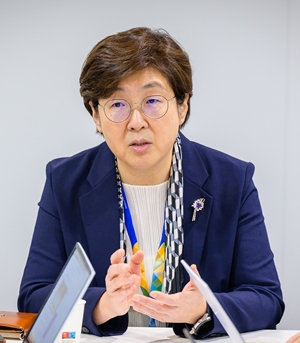- ADC offers new hope in TNBC treatment gap
- by Hwang, byoung woo | translator Alice Kang | Oct 28, 2025 06:11am
As the first antibody-drug conjugate (ADC) trial to significantly improve both overall survival (OS) and progression-free survival (PFS) in patients who cannot receive immunotherapy, it heralds a change in actual clinical practice.
At ESMO 2025, Professor Kyung-Hae Jung of Asan Medical Center emphasized that this study provides the first clinical evidence of survival benefit in a patient population that previously had no options beyond cytotoxic chemotherapy.
First Phase III study to improve Overall Survival...beyond cytotoxic chemotherapy dependence

Progression-free survival (PFS) was 10.8 months in the Datroway group, reducing the risk of disease progression or death by 43% compared to the chemotherapy group (5.6 months) (HR 0.57, p<0.0001). Overall survival (OS) was 23.7 months, extending by 5 months compared to the control group (18.7 months) (HR 0.79, p=0.0291).
Furthermore, the objective response rate (ORR) was 62.5% in the Datroway group and 29.3% in the chemotherapy group, showing more than double the difference.
Triple-negative breast cancer inherently remains an aggressive subtype with no actionable targets. When immunotherapy is not an option, the median overall survival (OS) is known to be around 12-13 months, making the study results particularly positive.
The findings are expected to fill a significant treatment gap, especially by offering a practical alternative for patients ineligible for immunotherapy.
Professor Jung stated, “The core finding of this study is the statistically significant improvement not only in progression-free survival but also in overall survival. This is not just a simple number but a change that alters the actual survival curve for patients.”
She further conveyed, “This demonstrates that we have moved beyond the era of relying solely on cytotoxic chemotherapy, showing that survival extension is now possible even in the non-immunotherapy group.”
This study is also notable for including patients with poor prognoses. It encompassed not only those ineligible for immunotherapy due to PD-L1 negativity or underlying conditions, but also patients who relapsed after immunotherapy and high-risk patients who relapsed within 6 months post-surgery.
Professor Jung remarked, “While most studies exclude such patients, this research reflects real-world clinical practice. It is exceptional that overall survival was extended by approximately 2 years even in this poor-prognosis patient group.”
She further explained, “The objective response rate exceeded 60%, and a high proportion of patients experienced rapid tumor shrinkage. Since triple-negative breast cancer often progresses rapidly, with patients experiencing significant tumor growth, these results could directly impact patient quality of life. The prolonged duration of response observed in this clinical trial demonstrates that not only the response rate but also the sustained responses can translate into survival.”
Filling the gap in HER2-negative and PD-L1-low expression... “New challenge in treatment sequencing strategy”
Professor Jung also projected that its use will vary depending on how the indication is approved domestically and which treatment receives insurance reimbursement first.
Analysis suggests it could become the sole treatment for patients with early-relapsed TNBC, pending approval by the Ministry of Food and Drug Safety (MFDS).
She stated, “The MFDS often approves treatments by directly adopting the clinical trial subject criteria as the approved indications. Therefore, if patients relapsing within 6 months are included in the approved scope, Datroway could effectively become the only treatment option for patients with early-relapsed TNBC.”
Professor Jung highlighted the need for future sequence studies focusing on HER2-low and PD-L1-low patient populations.
She projected, “While Enhertu (trastuzumab deruxtecan) could be considered for HER2-low patients, its prevalence in triple-negative breast cancer is low, and the similar payload structures of the two drugs could reduce efficacy when used sequentially. Clinical strategy regarding the sequence of drug administration in these patient groups will become increasingly important.”
The mechanism-based characteristics of TROP2-targeted therapies also warrant attention.
Professor Jung stated, “While most triple-negative breast cancer patients express TROP2, the efficacy was consistently demonstrated regardless of the expression level. Therefore, therapeutic benefits can be expected without the need for separate biomarker testing.”
She assessed, “These results provide significant data that point the way for future development of TROP2-targeted antibody-drug conjugates.”
Ultimately, the biggest practical hurdle to realizing therapeutic benefits is reimbursement coverage. Professor Jung emphasized that overcoming this accessibility barrier is crucial moving forward.
Professor Jung added, “Even a good drug remains inaccessible to patients without insurance coverage. Compared to existing cytotoxic anticancer drugs, new drugs inevitably carry higher prices, making reimbursement challenging from a cost-effectiveness perspective. Ultimately, drug pricing and reimbursement policies are decisive factors for access.”
-

- 0
댓글 운영방식은
댓글은 실명게재와 익명게재 방식이 있으며, 실명은 이름과 아이디가 노출됩니다. 익명은 필명으로 등록 가능하며, 대댓글은 익명으로 등록 가능합니다.
댓글 노출방식은
댓글 명예자문위원(팜-코니언-필기모양 아이콘)으로 위촉된 데일리팜 회원의 댓글은 ‘게시판형 보기’와 ’펼쳐보기형’ 리스트에서 항상 최상단에 노출됩니다. 새로운 댓글을 올리는 일반회원은 ‘게시판형’과 ‘펼쳐보기형’ 모두 팜코니언 회원이 쓴 댓글의 하단에 실시간 노출됩니다.
댓글의 삭제 기준은
다음의 경우 사전 통보없이 삭제하고 아이디 이용정지 또는 영구 가입제한이 될 수도 있습니다.
-
저작권·인격권 등 타인의 권리를 침해하는 경우
상용 프로그램의 등록과 게재, 배포를 안내하는 게시물
타인 또는 제3자의 저작권 및 기타 권리를 침해한 내용을 담은 게시물
-
근거 없는 비방·명예를 훼손하는 게시물
특정 이용자 및 개인에 대한 인신 공격적인 내용의 글 및 직접적인 욕설이 사용된 경우
특정 지역 및 종교간의 감정대립을 조장하는 내용
사실 확인이 안된 소문을 유포 시키는 경우
욕설과 비어, 속어를 담은 내용
정당법 및 공직선거법, 관계 법령에 저촉되는 경우(선관위 요청 시 즉시 삭제)
특정 지역이나 단체를 비하하는 경우
특정인의 명예를 훼손하여 해당인이 삭제를 요청하는 경우
특정인의 개인정보(주민등록번호, 전화, 상세주소 등)를 무단으로 게시하는 경우
타인의 ID 혹은 닉네임을 도용하는 경우
-
게시판 특성상 제한되는 내용
서비스 주제와 맞지 않는 내용의 글을 게재한 경우
동일 내용의 연속 게재 및 여러 기사에 중복 게재한 경우
부분적으로 변경하여 반복 게재하는 경우도 포함
제목과 관련 없는 내용의 게시물, 제목과 본문이 무관한 경우
돈벌기 및 직·간접 상업적 목적의 내용이 포함된 게시물
게시물 읽기 유도 등을 위해 내용과 무관한 제목을 사용한 경우
-
수사기관 등의 공식적인 요청이 있는 경우
-
기타사항
각 서비스의 필요성에 따라 미리 공지한 경우
기타 법률에 저촉되는 정보 게재를 목적으로 할 경우
기타 원만한 운영을 위해 운영자가 필요하다고 판단되는 내용
-
사실 관계 확인 후 삭제
저작권자로부터 허락받지 않은 내용을 무단 게재, 복제, 배포하는 경우
타인의 초상권을 침해하거나 개인정보를 유출하는 경우
당사에 제공한 이용자의 정보가 허위인 경우 (타인의 ID, 비밀번호 도용 등)
※이상의 내용중 일부 사항에 적용될 경우 이용약관 및 관련 법률에 의해 제재를 받으실 수도 있으며, 민·형사상 처벌을 받을 수도 있습니다.
※위에 명시되지 않은 내용이더라도 불법적인 내용으로 판단되거나 데일리팜 서비스에 바람직하지 않다고 판단되는 경우는 선 조치 이후 본 관리 기준을 수정 공시하겠습니다.
※기타 문의 사항은 데일리팜 운영자에게 연락주십시오. 메일 주소는 dailypharm@dailypharm.com입니다.
- [Reporter's View] Transparent info, the key to vaccine trust
- Reporter's view | Son, Hyung Min









